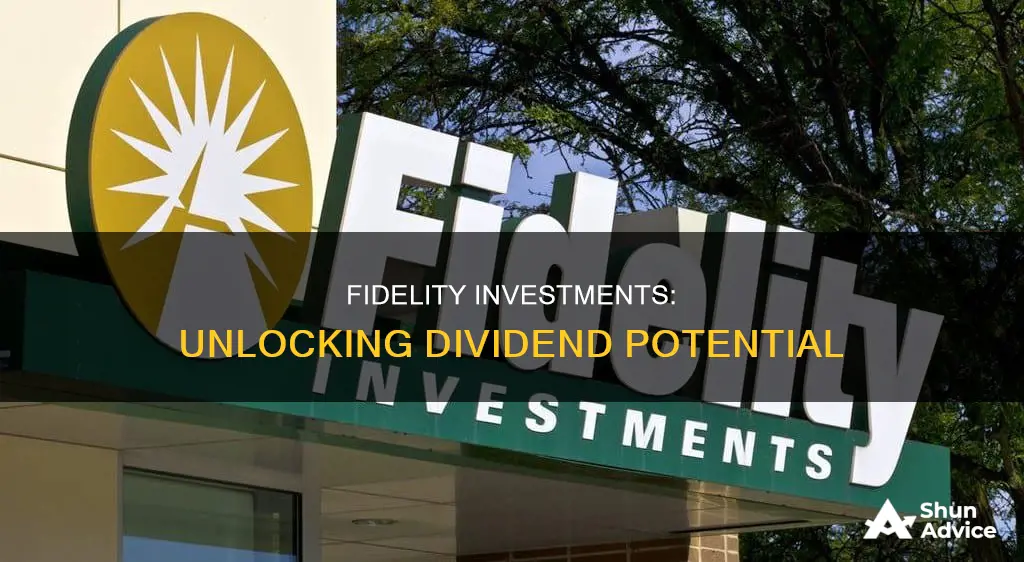
Fidelity Investments offers a range of dividend-paying investment options, including mutual funds, stocks, and ETFs. Dividends are a portion of a company's profits paid out to shareholders, providing a steady income stream or reinvestment opportunity. When choosing dividend-paying investments, it's essential to consider factors such as fund performance, costs, and tax implications. Fidelity provides resources to help investors make informed decisions about their dividend investments.
| Characteristics | Values |
|---|---|
| Investment Options | Stocks, Mutual Funds, ETFs, Bonds |
| Investment Types | Investment-grade taxable bond funds, Municipal bond funds, High-yield bond funds, Equity income funds, Asset allocation funds, International and global bond funds, Emerging market bond funds |
| Tax Implications | Qualified dividends are federally taxable at the capital gains rate; Non-qualified dividends are taxed at ordinary tax rates |
| Reinvestment Options | Reinvest to buy more shares, Move money to a cash account, Send money to another Fidelity mutual fund |
| Notable Funds | Fidelity Equity Dividend Income Fund (FEQTX), Fidelity Strategic Dividend & Income Fund (FSDIX), Fidelity Dividend Growth Fund (FDGFX) |
What You'll Learn

How to change dividends and capital gains distributions
When you own shares of mutual funds or stocks, you may receive distributions from these investments in the form of dividends and/or capital gains. You can choose how to receive these distributions. The most common methods include reinvesting the money to buy more shares of the mutual fund or stock, moving the money into your cash account, and/or sending the money to another Fidelity mutual fund.
You can update most accounts and securities online, but you cannot make changes to IRA-BDAs and PAS accounts. Certain types of business accounts also won't permit you to update dividends and capital gains distributions online unless you have full authority. There are also some securities that can't be updated, regardless of the account type.
To update your dividends and capital gains distributions, follow these steps:
- Log in to your Fidelity account and navigate to the "Dividends and Capital Gains" page.
- Find the security or mutual fund you want to change.
- Under "Action", select "Update" to access the "Update Distributions" page.
- To update a security: On the "Update Distributions" page, you will see dividends and capital gains combined in one row. Make your selection and choose whether you want to apply the change to all current and/or future equity positions in this account.
- To update a mutual fund: On the "Update Distributions" page, you will see dividends and capital gains in separate rows. Make your selection and choose whether you want to apply the change to all current and/or future mutual fund purchases, transfers, and deposits.
- Select "Update" and review the confirmation page to ensure your changes are correct.
- Your changes will be effective immediately and will be reflected on your "Dividends and Capital Gains" summary page.
Please note that the "Dividends and Capital Gains" update pages are typically unavailable from 9:30 p.m. to 10:30 p.m. ET, Monday through Friday.
The Debt Dilemma: Navigating Investments and Loans the Dave Ramsey Way
You may want to see also

Dividend-capture strategies
The strategy is centred around four key dates:
- Declaration date: The board of directors announces dividend payment. This is the date when the company declares its dividend. It occurs well in advance of the payment.
- Ex-dividend date: The security starts to trade without the dividend. The day before the ex-dividend date is the last day to buy a stock and be eligible to receive the dividend payment. The ex-date is also the day when the stock price often drops in accordance with the declared dividend amount. Traders must purchase the stock prior to this critical day.
- Date of record: Current shareholders on record will receive a dividend. This is the day when a company records which shareholders are eligible to receive the dividend.
- Pay date: This is the day when the company issues dividend payments.
The dividend capture strategy is fairly simple: an investor purchases shares of the stock before the ex-dividend date and sells the shares on the ex-dividend date or any time thereafter. If the share price does fall after the dividend announcement, the investor may wait until the price bounces back to its original value.
Theoretically, the dividend capture strategy shouldn't work. If markets operated with perfect logic, then the dividend amount would be exactly reflected in the share price until the ex-dividend date, when the stock price would fall by exactly the dividend amount. However, since markets do not operate with such mathematical perfection, it doesn't usually happen that way. Most often, a trader captures a substantial portion of the dividend despite selling the stock at a slight loss following the ex-dividend date.
Dividend capture strategies are not without their risks. The potential gains from a pure dividend capture strategy are typically small, while possible losses can be considerable if a negative market movement occurs within the holding period. A drop in stock value on the ex-date that exceeds the amount of the dividend may force the investor to maintain the position for an extended period of time, introducing systematic and company-specific risk into the strategy. Adverse market movements can quickly eliminate any potential gains from this dividend capture approach. In order to minimize these risks, the strategy should be focused on the short-term holdings of large blue-chip companies.
Another risk is that of brokerage fees. The dividend capture strategy is probably not a smart one to use with a full-commission broker. A large amount of principal is required to begin with, and trading large blocks of shares on a daily basis can easily result in commissions being paid that far outweigh the dividends received.
EPZ Investments: Why People Take the Risk
You may want to see also

Dividend-paying stocks
Benefits of Dividend-Paying Stocks
Factors to Consider when Choosing Dividend-Paying Stocks
When selecting dividend-paying stocks, it's important to assess the company's performance, both long-term and recent, and compare it against relevant benchmarks and market indexes. Additionally, consider the costs associated with the investment to ensure they don't erode your profits. Look for companies with strong fundamentals and the potential for long-term growth, as these are more likely to sustain dividend payments.
Examples of Dividend-Paying Stocks
Several companies are known for their dividend payments, including well-established names such as Procter & Gamble, which has a long history of annual dividend payments. More recently, tech giants like Apple and Microsoft have also started paying dividends.
Fidelity's Dividend-Paying Investment Options
Fidelity offers a range of dividend-focused investment options, including mutual funds and exchange-traded funds (ETFs). Here are some examples:
- Fidelity Equity Dividend Income Fund (FEQTX): Actively managed fund investing primarily in dividend-paying stocks, with a focus on long-term capital appreciation. It has an annual gross expense ratio of 0.58%.
- Fidelity Strategic Dividend & Income Fund (FSDIX): Actively managed fund investing in dividend-paying companies and incorporating bonds. It has an expense ratio of 0.68%.
- Fidelity Dividend Growth Fund (FDGFX): Focuses on investing in companies that have the potential to initiate or increase their dividend payments over time.
- Fidelity's Mutual Fund Picks: Offer a wide range of mutual funds with monthly or quarterly dividend payments, including investment-grade taxable bond funds, municipal bond funds, high-yield bond funds, equity income funds, asset allocation funds, and international/global bond funds.
Considerations for Dividend-Paying Stocks
While dividend-paying stocks offer benefits, it's important to remember that they come with risks similar to other stock investments. The value of dividend-paying stocks can fluctuate significantly, and there is always the possibility of losing your initial investment. Additionally, companies that pay dividends may have a reduced market value, as dividend payments affect their net worth.
Americans: Investors or Not?
You may want to see also

Types of dividend-producing mutual funds
Dividend-paying mutual funds are a great way to get exposure to dividend stocks through a managed product. There are several types of dividend-producing mutual funds, each with its own unique characteristics and benefits. Here are some of the most common types:
Exchange-Traded Funds (ETFs)
ETFs are a popular type of dividend-producing mutual fund because they offer low costs and broad diversification. ETFs track a specific market index and aim to match its performance. They are traded like stocks, making them easy to buy and sell. Examples of dividend-focused ETFs include the Vanguard Dividend Appreciation ETF (VIG) and the Vanguard High Dividend Yield ETF (VYM).
Actively Managed Mutual Funds
These funds are actively managed by fund managers who aim to beat a specific benchmark index. They typically invest in a diverse range of dividend-paying stocks and may have higher expense ratios than passive ETFs. The Fidelity Equity Dividend Income Fund (FEQTX) is an example of an actively managed mutual fund, investing primarily in American dividend-paying stocks.
Index Funds
Index funds aim to replicate the performance of a specific stock market index, such as the S&P 500 or the Nasdaq US Dividend Achievers Select Index. By holding the same stocks as the index, these funds provide broad diversification and relatively low costs. The Vanguard High Dividend Yield Index Admiral Shares (VHYAX) is an example of an index fund, replicating the FTSE High Dividend Yield Index.
Dividend Growth Funds
Dividend growth funds focus on investing in companies that have the potential to increase their dividend payouts over time. These funds seek out financially healthy companies with strong earnings growth potential and a history of raising dividends. The Vanguard Dividend Growth Fund (VDIGX) and the T. Rowe Price Dividend Growth Fund (PRDGX) are examples of dividend growth funds.
High-Dividend Yield Funds
High-dividend yield funds appeal to investors who prefer consistent income. These funds invest in stocks and bonds that offer higher-than-average dividend payments. The Vanguard High Dividend Yield Index Admiral Shares (VHYAX) and the Federated Strategic Value Dividend Fund (SVAAX) are examples of high-dividend yield funds.
When choosing a dividend-producing mutual fund, it is important to consider the fund's performance, costs, and how it fits into your overall investment portfolio.
Should You Invest in GE Now?
You may want to see also

How dividends are taxed
Dividends are usually taxable income. How they are taxed depends on your income, filing status, and whether the dividend is qualified or nonqualified.
Qualified Dividends
Qualified dividends are taxed at 0%, 15%, or 20%, depending on taxable income and filing status. They are considered a capital gain rather than income. To be considered a qualified dividend, the dividend must be:
- Paid by a U.S. corporation or qualifying foreign entity
- Recognized as a dividend by the IRS (some things that don't count as dividends include premiums paid by an insurance company, annual distributions by credit unions, and "dividends" from co-ops or tax-exempt organizations)
- Held by the shareholder for more than 60 days in the 121-day period that began 60 days before the ex-dividend date (the day by which you must own the stock to receive the dividend)
Nonqualified Dividends
Nonqualified dividends are taxed as income at rates up to 37%.
Reporting Dividend Income
After the end of the year, you will receive a Form 1099-DIV or a Schedule K-1 from your broker or any entity that sent you at least $10 in dividends and other distributions. Even if you didn't receive the dividend in cash (e.g., if you automatically reinvested it), you still need to report it. You also need to report dividends from investments you sold during the year. If you received over $1,500 of taxable ordinary dividends, you must report these on Schedule B (Form 1040).
Cattle: A Smart Investment
You may want to see also
Frequently asked questions
Some of the best dividend-paying stock funds include the Vanguard Dividend Appreciation ETF, the Fidelity Equity Dividend Income Fund, the Vanguard Equity Income Fund Investor Shares, and the Fidelity Strategic Dividend & Income Fund.
There are several types of dividend-producing mutual funds, including investment-grade taxable bond funds, municipal bond funds, high-yield bond funds, and equity income funds.
Dividends are federally taxable at the capital gains rate, which depends on the investor's modified adjusted gross income (MAGI) and taxable income. The current rates are 0%, 15%, 18.8%, 20%, and 23.8%.
You can typically choose how to receive these distributions, such as reinvesting the money to buy more shares, transferring the money to your cash account, or sending it to another mutual fund.







